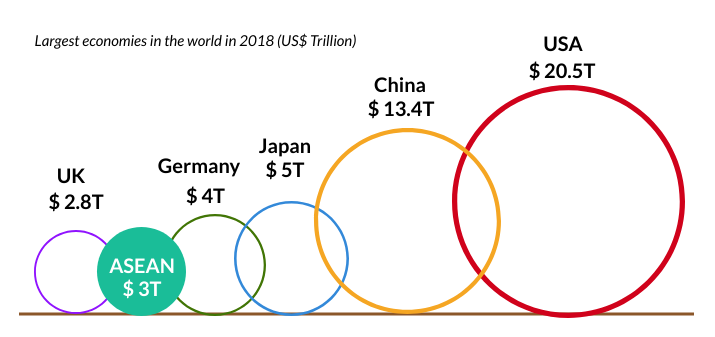
WRITTEN BY XUAN NGUYEN
The South-East Asian region consists of 10 countries with a combined GDP of USD 3 trillion (the 5th largest in the world) and a population of 649.1 million people[1]. Over the past few years, the region has emerged as a location for manufacturing diversification, particularly as a result of the USA–China trade war and, most recently, the Covid-19 pandemic
Technology transfers are the key enablers in the supply chain relocation process, and intellectual property (IP) is considered to be the crucial element – the factor that contributes the value. In this article, we will provide you with some tips on how to build and manage your IP portfolio in relation to technology transfers in South-East Asia.
Why is IP important in technology transfers?
A broad definition of technology will be used here, one including not only production technology, but also management expertise, marketing skills and general intangible corporate assets. Commercially exploiting technology across geopolitical borders can be managed through licensing agreements, joint ventures or by setting up your own business in order to share advanced skills, knowledge, or facilities among interested parties.
Companies most commonly transfer their technology by licensing their IP rights (such as patents, trade marks, designs, software, trade secrets, know-how, etc.). Protecting your IP before disclosing it is crucial to ensuring your monopoly on the information in question, allowing you to expand your market presence, providing you with a return on investment in research and development (R&D) and encouraging further innovation. According to the Ocean Tomo survey, today intangible assets have increased their contribution to account for up to 90% of a company’s value[2].

Secure your IP through registration, non-disclosure agreements (NDAs) and a strategic plan
The first step in managing your IP is to identify it. Therefore, in your transfer strategy, you should think about what kind of intangible assets you are considering disclosing to your potential partners. Based on your resources and target destination, evaluate the elements you want to be part of your technology transfer strategy, and consider whether it is beneficial to monetise the specific IP in question (such as the patent, trade mark, design, software, trade secrets, know-how, or a combination of the above).
For example, in a franchising deal, you not only transfer your brand and business model, but also operating manuals, quality control procedures, training policies, marketing strategies, business advisory support systems and many other confidential aspects of your business. Be aware of all the information you will disclose to your partner during the process – from commencing negotiation until entering into a deal – so that you can anticipate the possible risks and initiate a suitable protection plan.
You must be aware that IP protection is territorial. Therefore you need to formally register patents, trade marks and designs in each country you want to be protected in. An IP protection strategy must be front and centre when considering investing in South-East Asian countries. Obtaining registration before the start of a technology transfer negotiation is ideal. However, even having an application in place before opening talks is worthwhile; it strengthens your position and reduces the risk of a failed discussion ending up with the theft of your IP by your potential local partners.
In the era of digitalisation, the software is a crucial part of the IP involved in many technology transfer deals. You should pay special attention when licensing your software; there are two main ways to protect it, patent and copyright. Patents ensure extraordinarily strong protection but are not easy to obtain, firstly because it’s a long and costly procedure, secondly because not all software is deemed to be patentable. Therefore, you probably have to rely on protection under copyright law. In almost all South-East Asian countries works are automatically protected by copyright upon their creation, however a system for voluntary registration also exists. Copyright registration is very useful when there are disputes over a copyrighted work. It’s much to better to have it before entering a tech transfer agreement.
There is no registration system for trade secrets, know-how or other intangible assets, therefore companies should always have a strategic policy in place to retain such assets, and their competitive edge. A good starting point is to sign an NDA with your potential partner before entering into any initial negotiations, and ensure that it’s translated into the local language. This is also a way to detect the intentions of your potential partners, and to test their reliability.
It’s an unfortunate truth that people won’t pay for what they can steal. Many licensees attempt to reverse-engineer your products to save costs and gain an advantage in the marketplace (i.e. they are able to sell their products at much lower prices). Under current IP legislation, there is little you can actually do about this process other than to build a strategy that prevents such activities from taking place. For example, in your technology transfer plan, you may consider having certain components of your products manufactured/assembled by different parties, or using separate locations to help reduce the risk of your IP being misappropriated.
Searching for a partner and due diligence
The crucial factor in the success of technology transfers is choosing the right partner. During the negotiation process, you are going to disclose your IP in order to attract potential partners. It is worth spending some time reviewing all the assets in question, including any registered IP belonging to your potential partners, any litigation in which they have been involved, or any issues that could arise in the future when signing a deal with them.
Entering into a contract
The risk to IP associated with technology transfers varies depending on the type of IP you want to transfer and the form of collaboration planned (such as licensing, a joint venture or setting up your own business). You should analyse the potential risks and include the necessary clauses in contracts to prevent IP violation.

First of all, make sure a confidentiality clause or NDA is a part of your contract. Taking the fact that the information may be used by your partner’s employees – or that the information might be disclosed to third parties – into account, appropriate measures to protect confidential information should be clearly written into the contract.
It is also worth having a formal procedure in place to deal with the identification of both the existing IP and IP that would arise in the future. In many cases, your partner may be able to improve on your IP and use it to develop another generation of products. Therefore, it is wise to include a clause that deals with the ownership of any potential improvements.
Importantly, companies must ensure that the contract allows local enforcement methods to stop the sources of IP violation, rather than reverting to EU legislation or systems of arbitration. In cases of infringement, you have the right to seek direct remedies from the local authorities. This resource can enable you to quickly obtain emergency injunctions, search-and-seize orders or asset-freezing orders, which are especially helpful in cases of trade secret theft by an employee or a third party. It is common practice to include an accompanying arbitration clause as a secondary means of resolving disputes. In the South-East Asian region, Arbitration in Singapore is usually recommended as the country has the advantage of excellent legal and technological expertise, a highly skilled judiciary and widespread English fluency.
South-East Asia has become a promising destination for supply chain relocation. Technology transfers are the key enablers of this process. However, the risks of IP infringement there always threaten your revenue and reputation. Companies should understand the degree of their exposure to risk and make sure to put the appropriate measures in place to protect their intangible assets when investing in the region.
For more information on technology transfers in South-East Asia, check out our latest guide here.
The South-East Asia IP SME Helpdesk is an EU initiative that provides free, practical IP advice to European SMEs in South-East Asia. EU companies can send questions to question southeastasia-iprhelpdesk [dot] eu (question[at]southeastasia-iprhelpdesk[dot]eu) and will receive a reply within 3 working days.
southeastasia-iprhelpdesk [dot] eu (question[at]southeastasia-iprhelpdesk[dot]eu) and will receive a reply within 3 working days.
[1] https://www.aseanstats.org/wp-content/uploads/2019/11/ASEAN_Key_Figures_2019.pdf
[2] https://www.oceantomo.com/intangible-asset-market-value-study/
Details
- Publication date
- 1 October 2020
- Author
- Executive Agency for Small and Medium-sized Enterprises
